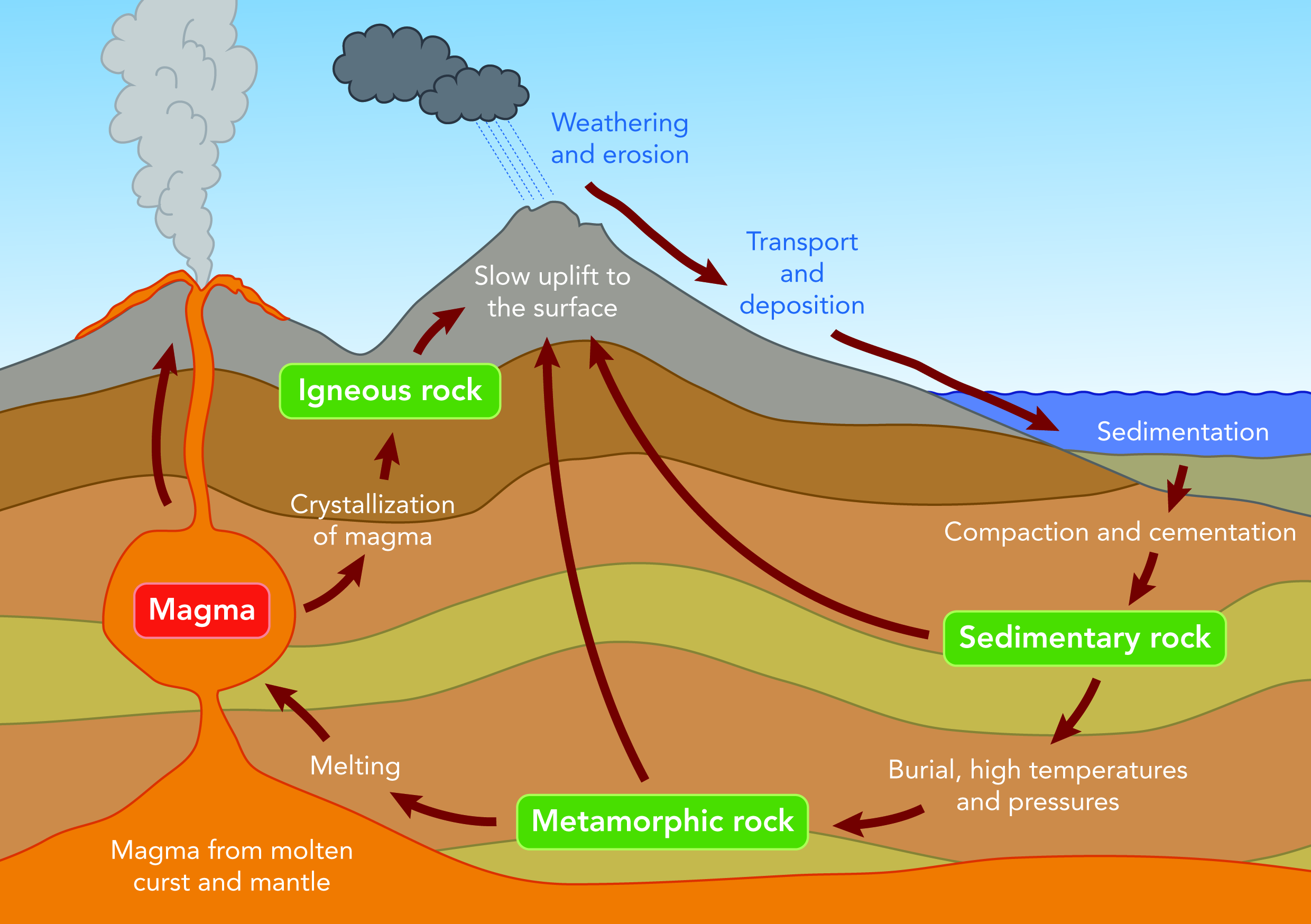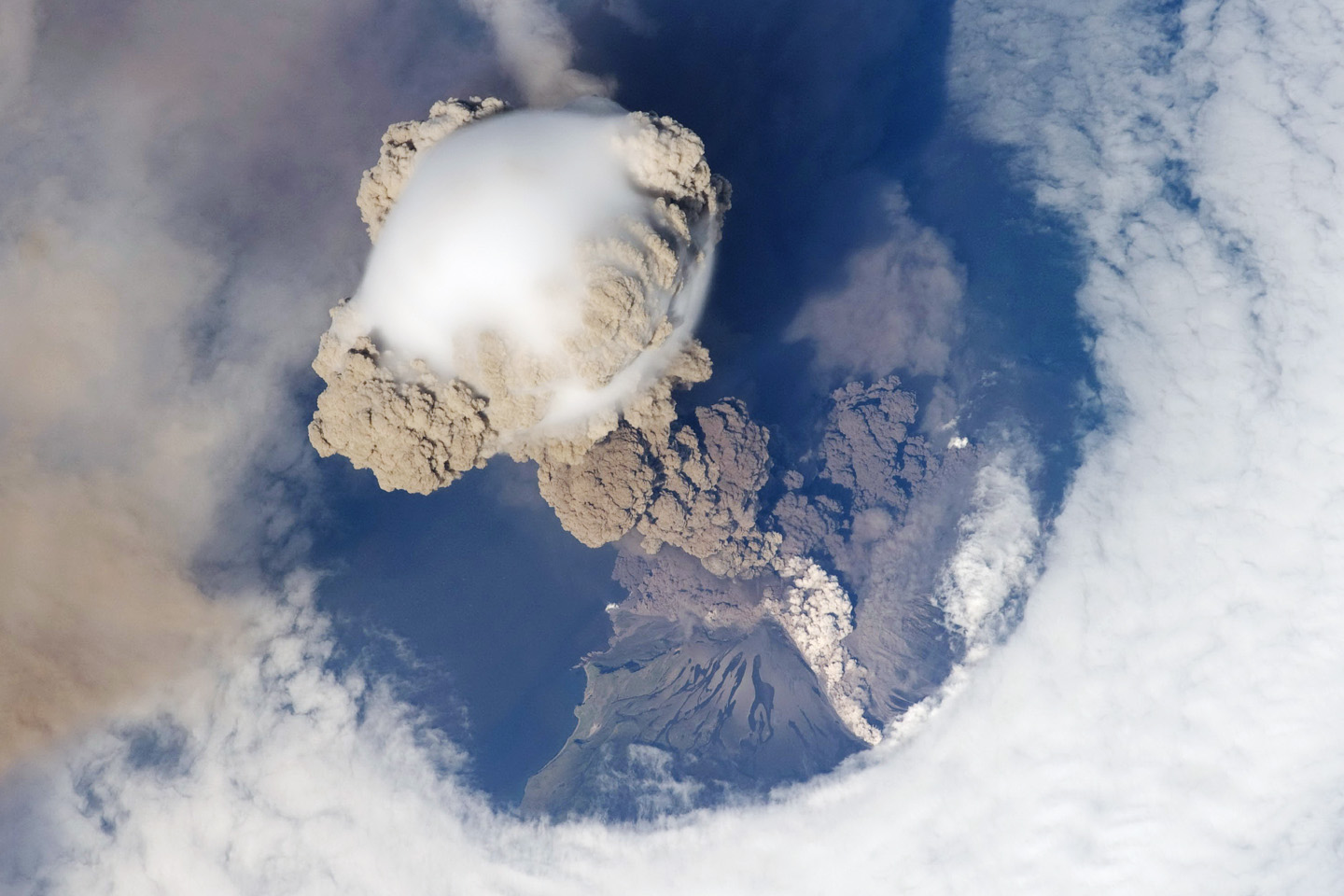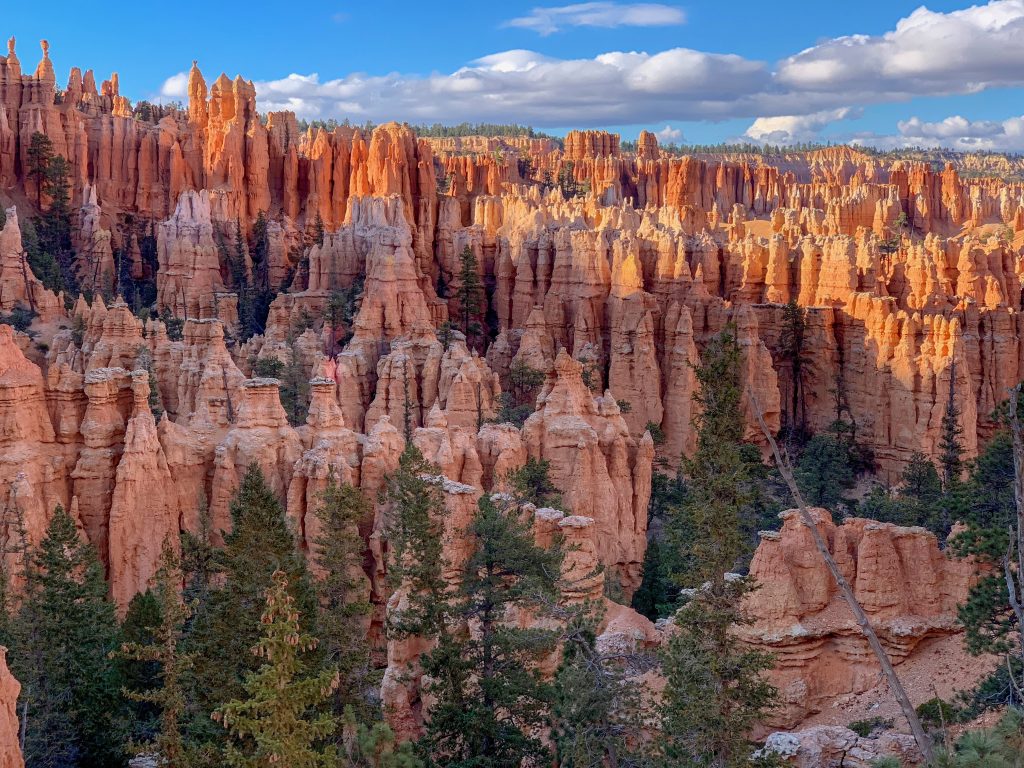Planet Earth
3.5 The Rock Cycle
The most fundamental view of Earth’s materials is the rock cycle, which presents the primary materials that comprise the Earth and describes how they form and relate to each other. The rock cycle is usually said to begin with a hot molten liquid rock called magma or lava. Magma forms under the Earth’s surface in the crust or mantle and erupts on Earth’s surface as lava. When magma or lava cools, it solidifies by crystallization, in which minerals grow within the magma or lava. The rock that results from this is an igneous rock from the Latin word ignis, meaning “fire.”

Igneous rocks and other rocks on Earth’s surface are exposed to weathering and erosion processes to produce sediments. Weathering is rocked’ physical and chemical breakdown into smaller fragments, and erosion removes those fragments from their original location. These fragments or grains are considered sediments once igneous rocks are broken down and transported. Sediments such as gravel, sand, silt, and clay can be transported by water in streams, ice in the form of glaciers, and air in the form of wind. Sediments ultimately come to rest in a process known as deposition. Then, the deposited sediments accumulate in place, often underwater, such as in a shallow marine environment, and get buried.
Within the burial process, the sediments go through compaction by the weight of overlying sediments and cementation as minerals in groundwater glue the sediments together. Compacting and cementing sediments together is lithification, and lithified sediments are considered sedimentary rock, such as sandstone and shale. Other sedimentary rocks, known as chemical sedimentary rocks, are not made of weathered and eroded sedimentary fragments. The direct chemical precipitation instead makes them of minerals.
Pre-existing rocks may be metamorphosed into a metamorphic rock; meta– means “change,” -morphos means “form” or “shape.” When rocks are subjected to extreme temperatures or pressures, the minerals alter into enlarged crystals or entirely new minerals with a similar chemical makeup. These elevated temperatures and pressures can occur when rocks are buried deep within the Earth’s crust or encounter hot magma or lava. In some cases, the temperature and pressure conditions can allow rocks to melt and create magma and lava, showing the cyclical nature of the rock cycle as new stones are born. Click here to learn about igneous, sedimentary, and metamorphic rocks from the Utah Geologic Survey (UGS).
Igneous Rocks
Igneous rocks form from the cooling and hardening of molten magma in many environments. Their composition and texture identify these rocks. More than 700 distinct types of igneous rocks are known.

Magma Composition
The rock beneath the Earth’s surface is sometimes heated to high enough temperatures that it melts to create magma. Different magmas have different compositions and contain whatever elements were in the rock that melted. Magma also contains gases. (Reading: Types of Rocks | Geology, n.d.) However, the main elements are the same as those in the crust. Therefore, whether rock melts to create magma depends on:
- Temperature: Temperature increases with depth, so melting is more likely to occur at greater depths.
- Pressure: Pressure increases with depth, but increased pressure raises the melting temperature, making melting less likely to occur at higher pressures.
- Water: The addition of water changes the melting point of rock. As the number of water molecules increases, the melting point decreases.
- Rock composition: Minerals melt at different temperatures, so the temperature must be high enough to melt some minerals in the rock. Therefore, the first mineral to melt from a rock will be quartz (if present), and the last will be olivine (if present).
The minerals at the lowest temperatures will melt as a rock heats up. Partial melting occurs when the temperature of a rock is high enough to melt only some of the minerals in the rock. The minerals that will melt will be those that melt at lower temperatures. Fractional crystallization is the opposite of partial melting. This process describes the crystallization of different minerals as magma cools. (Igneous Rocks | Geology, n.d.)
Bowen’s Reaction Series indicates the temperatures at which minerals melt or crystallize. An understanding of the way atoms join to form minerals leads to an understanding of how different igneous rocks form. Bowen’s Reaction Series also explains why some minerals are always found together, and some are never.
The liquid and solid chemical composition will differ if the liquid separates from the solids in partial melting or fractional crystallization. When that liquid crystallizes, the resulting igneous rock will have a different composition from the parent rock. (Reading: Types of Rocks | Geology, n.d.)
Intrusive Igneous Rock
Igneous rocks are called intrusive when they cool and solidify beneath the surface. Intrusive igneous rocks form plutons and so are also called plutonic. A pluton is an igneous intrusive rock body that has cooled in the crust. When magma cools within the Earth, the cooling proceeds slowly. Therefore, intrusive igneous rocks cool slower than extrusive igneous rocks, allowing more massive crystal structures to develop.
Igneous rocks make up most of the rocks on Earth. Most igneous rocks are buried below the surface and covered with sedimentary rocks or beneath the ocean water. However, some geological processes have brought igneous rocks to the surface. Yosemite is a classic example of intrusive igneous rock. First, the molten magma never reached Earth’s surface, so the molten material had millions of years to cool down slowly to form granite. Later, geologic forces and erosion caused those granite plutons to surface today.
Extrusive Igneous Rock
Igneous rocks are called extrusive when they cool and solidify above the surface. These rocks usually form from a volcano, also called volcanic rock. Extrusive igneous rocks cool much more rapidly than intrusive rocks, reducing the time for crystal structure to form within the rocks.
Cooling rate and gas content create a variety of rock textures. For example, lavas that cool exceptionally rapidly may have a glassy texture. Those with many holes from gas bubbles have a vesicular texture. (Igneous Rocks | Geology, n.d.)
Human Uses of Igneous Rock
Igneous rocks have many uses, including creating buildings and statues, kitchen countertops, abrasive material for household products, or smoothing skin. For example, ground-up pumice stone is sometimes added to toothpaste as an abrasive material to scrub teeth. Peridotite is sometimes mined for peridot, a type of olivine used in jewelry. Diorite was used extensively by ancient civilizations for vases and other decorative artwork and is still used for art today.
Sedimentary Rock
Sandstone is one of the common sedimentary rocks that form from sediments. However, there are many other types. Sediments may include:
- Fragments of other rocks often have been worn down into small pieces, such as sand, silt, or clay.
- Organic materials, or the remains of once-living organisms.
- Chemical residues are left behind after the water evaporates from a solution.
Rocks at the surface undergo mechanical and chemical weathering. These physical and chemical processes break the rock into smaller pieces. Physical weathering breaks the rocks apart, while chemical weathering dissolves the less stable minerals. These original elements of the minerals end up in solution, and new minerals may form. In erosion, sediment is removed and transported by water, wind, ice, or gravity.

Streams carry vast amounts of sediment. The more energy the water has, the larger the particles it can carry. A rushing river on a steep slope might be able to carry boulders. As this stream slows down, it no longer has the energy to carry large sediments and drop them. A slower-moving stream will only carry smaller particles.
Sediments are deposited on beaches and deserts, at the bottom of oceans, lakes, ponds, rivers, marshes, and swamps. Fast-moving avalanches and slow-moving glaciers can drop large piles of sediment. Wind can only transport sand and smaller particles. The type of sediment deposited will determine the kind of sedimentary rock that can form. Distinct sedimentary rock colors are determined by the environment where they are deposited. Red rocks form where oxygen is present, while darker sediments form when the environment is oxygen-poor. (Reading: Mining and Mineral Use | Geology, n.d.)
Sedimentary Rock Formation
Accumulated sediments harden into a rock by a process called lithification. Two essential steps are needed for sediments to lithify. First, sediments are squeezed together by the weight of overlying sediments on top of them, called compaction. Cemented, non-organic sediments become clastic rocks. If organic material is included, they are bioclastic rocks.
Fluids fill the spaces between the loose sediment particles and crystallize to create a rock by cementation. When sediments settle out of calmer water, they form horizontal layers. One layer is deposited first, and another layer is deposited on top. So, each layer is younger than the layer beneath it. When the sediments harden, the layers are preserved. Sedimentary rocks formed by crystallizing chemical precipitates are called chemical sedimentary rocks.
Biochemical sedimentary rocks form in the ocean or a salt lake. Living creatures remove ions, such as calcium, magnesium, and potassium, from the water to make shells or soft tissue. When the organism dies, it sinks to the ocean floor to become biochemical sediment, which may become compacted and cemented into solid rock. (Reading: Mining and Mineral Use | Geology, n.d.)
Human Use of Sedimentary Rock
Sedimentary rocks are used as building stones but are not as hard as igneous or metamorphic rocks. In addition, sedimentary rocks are used in construction. Sand and gravel are used to make concrete; they are also used in asphalt. Many economically valuable resources come from sedimentary rocks. Iron ore and aluminum are two examples. (Reading: Mining and Mineral Use | Geology, n.d.)
Metamorphic Rock
Metamorphism is the addition of heat and pressure to existing rocks, which causes them to change physically and chemically to become new. Metamorphic rocks may change so much that they resemble the original rock.
Any type of rock – igneous, sedimentary, or metamorphic – can become a metamorphic rock. All needed is enough heat and pressure to alter the existing rock’s physical or chemical makeup without melting the rock entirely. Rocks change during metamorphism because the minerals must be stable under the new temperature and pressure conditions. The need for stability may cause the structure of minerals to rearrange and form new minerals. In addition, ions may move between minerals to create minerals of different chemical compositions. With their alternating dark and light crystal bands, Hornfels is an excellent example of how minerals rearrange themselves during metamorphism.
Extreme pressure may also lead to foliation, the flat layers that form in rocks as pressure squeezes the stones. Foliation typically forms when pressure is exerted in only one direction. However, metamorphic rocks may also be non-foliated. For example, quartzite and limestone are non-foliated. The two main types of metamorphism are both related to heat within Earth:
- Regional metamorphism: Changes in enormous quantities of rock over a wide area caused by extreme pressure from overlying rock or compression caused by geologic processes. Deep burial exposes the rock to hot temperatures.
- Contact metamorphism: Changes in a rock in contact with magma because of the magma’s extreme heat.
The Utah Geologic Survey has several resources related to landforms in Utah. They have also created a fun story map called GeoSights of famous geologic sights within Utah.

